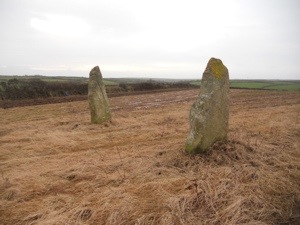By Alan Simkins
It’s that time of year again, when I take a short holiday break in Cornwall, and subsequently there will be a short series of posts about our exploits there. First up, a short look at the Higher Drift Stones.
This pair of standing stones, also known as the Triganeeris Stones, or the Sisters, lie in a field just south of the A30 some three miles west of Penzance.
The field is often in crop, and so is inaccessible, but if you time your visit right, it’s possible with care to get up close to these stones which stand some 18 feet apart, aligned NW to SE. The smaller stone is around 7.5 feet tall, and it’s larger sister to the south a foot taller at around 8.5 feet. The larger stone has a natural diagonal crevice on it’s south face, which is home to a large colony of snails!
W.C.Borlase excavated the site in 1871, and found a pit had been cut between the stones (offset and slight north of centre), but no finds were recorded by him. Despite this lack of evidence, the stones are assumed by comparison with similar stone pairs, to be of Middle Bronze Age date (1000-1500 bce).
Why sisters? This alludes to the common legend found at many Cornish sites where young women are ‘turned to stone’ for dancing or playing on the Sabbath. In this case, as with the Boscawen Un circle further to the west, the musician is thought to be the ‘Blind Fiddler’ or Tregonebris Longstone, which lies half a mile to the west of the Drift Stones. Payne, in Romance of the Stones, suggests that the name Triganeeris could either indicate a farming origin connected with pigs, or more intriguingly via a Welsh linguistic connection, a place to dwell, or to die.
The nearest ancient site to the Sisters is not the Blind Fiddler mentioned above, but the Tresvennack Pillar. This 11.5 feet tall stone sits approximately a quarter of a mile to the southeast, across the other side of the Lamorna Valley. It’s entirely possible that the sites are, or have been in the past, intervisible.





4 comments
Comments feed for this article
03/01/2013 at 11:08
Craig Weatherhill
Triganeeris was a small landholding, the farm buildings of which have largely disappeared. The name has no connection with pigs or birth, but was Tregeneres 1327. This is Cornish: tre, “farm, settlement” + a personal name *Generet (unlike Welsh, Cornish underwent assibilation c.1200, softening certain letters, so Generet softened to Generes. Nant, “valley” became nans, etc. The Tresvennack Pillar (in fact, rather taller than 11.5 feet) is visible from the stones at Higher Drift.
03/01/2013 at 13:22
Alan S.
Many thanks for the clarification Craig. I was going largely on the information in Romance of the Stones by Robin Payne, as there was no information/speculation about the name in my copy of your Cornovia work.
03/01/2013 at 13:35
Craig Weatherhill
I’ve closely studied Cornish place-names for about 30 years, have a massive archive on their historic forms, and have published 3 books on the subject which I view as a branch of archaeology. Please feel free to consult me for any advice on our place-names. I’d be more than happy to help.
03/01/2013 at 13:46
Alan S.
Much appreciated Craig, I may well take you up on that offer in future!